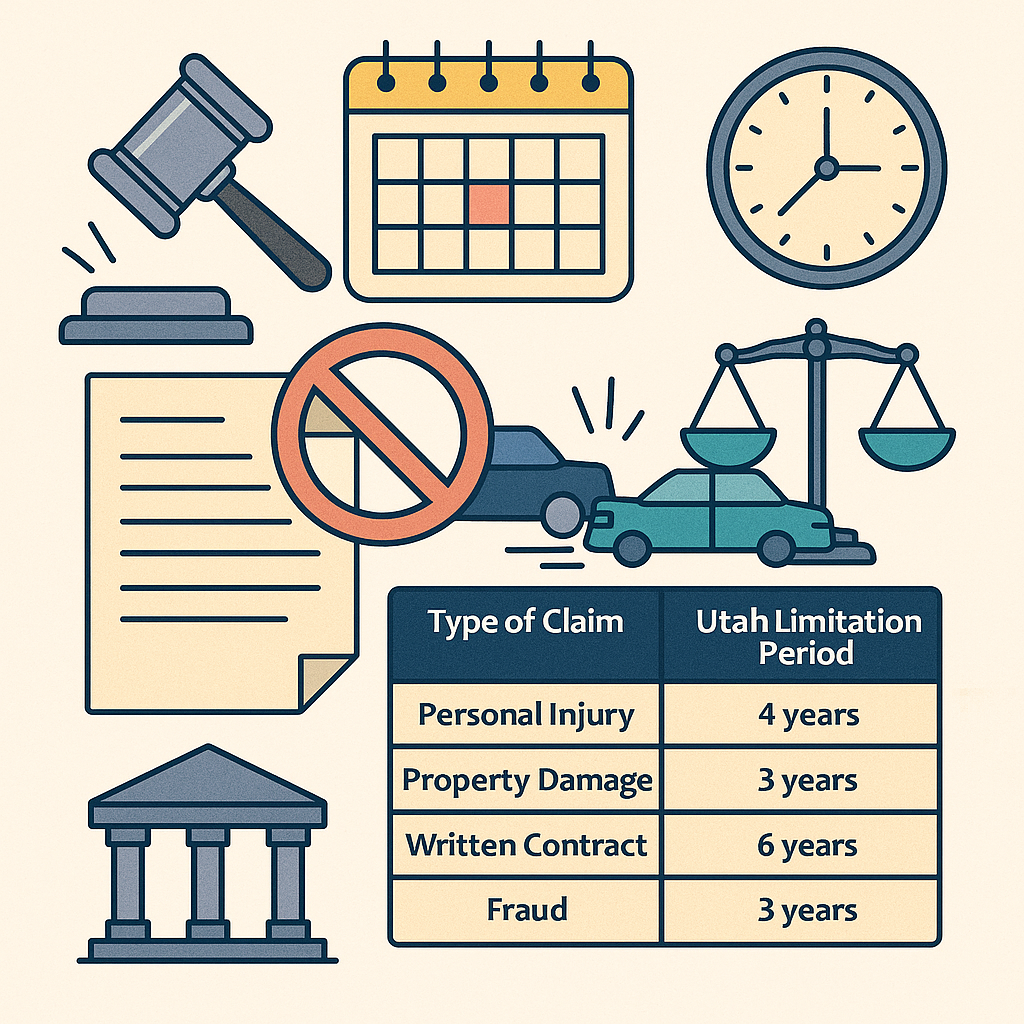What Are the Statutes of Limitations for Common Utah Claims?
Plain-English deadlines for Utah cases plus discovery rule, tolling, and government claim steps
In Utah, if you miss the filing deadline for your lawsuit even by a day you can lose your right to bring the case. Whether it is a car accident, unpaid contract, property damage, or fraud claim, knowing the time limits is critical. This guide breaks down the major statutes of limitations that affect everyday Utah cases.
Case Scenario – When Time Runs Out
Imagine this: you are rear-ended on I-15 near Lehi and suffer a neck injury. You focus on recovery and deal with insurance for a while. Four years pass and suddenly it is too late. Utah’s statute of limitations for personal injury cases is four years from the date of the crash. Once that period ends, the court will dismiss your case no matter how strong your evidence is.
The same danger applies to other civil claims. A broken promise on a written contract is six years. Damage to your property is three years. Defamation or fraud is often three years. These deadlines are set by law, and once the clock expires, so do your rights.
Quick Reference – Common Utah Deadlines
Use this quick list to spot your window. Each item shows the limitation period and the Utah Code reference.
When the Clock Starts
In most Utah cases, the statute of limitations begins on the date of the injury or breach. For certain cases like medical malpractice or fraud, Utah’s discovery rule may apply. That means the clock starts when you knew or should have known about the injury or damage.
Example. You discover a construction defect in your new home two years after completion. The time limit may start when the defect is found, not when the work was done.
Tolling and Exceptions
Sometimes the clock pauses. In Utah, tolling may apply if:
- The injured person is a minor or mentally incapacitated
- The defendant leaves the state or hides to avoid service
- The harm was not reasonably discoverable right away
Once the reason for tolling ends, the clock resumes. Courts apply these exceptions narrowly, so it is risky to rely on them without professional advice.
Suing the Government
Claims against Utah government agencies have shorter timelines and extra steps. Under the Utah Governmental Immunity Act, you must file a notice of claim within one year of the incident. The government then has time to approve or deny it. If denied, you typically have one year from that denial to file a lawsuit. Miss either deadline and your claim ends automatically.
Pitfalls and Practical Filing Tips
- Confirm your claim type early – the deadline depends on how your case is categorized
- Do not wait for negotiations – insurance talks do not pause the statute
- Document discovery dates – critical for fraud or medical malpractice
- Do not count on private extensions – courts rarely enforce agreements that contradict statutes
- File in the right court and serve the right party – errors do not stop the clock
- Consult a Utah attorney early to verify accrual and tolling timelines
Video and Social Learning Hub
YouTube – Statutes of Limitations
Need Help Applying This to Your Situation?
Understanding Utah’s statutes of limitations can make or break your case. Whether you are dealing with a contract dispute, car accident, or professional negligence, acting within the right timeframe is key. For edge cases or uncertainty about when your clock starts, seek legal advice from a licensed Utah attorney.
Talk to a Utah AttorneyFor more plain-English legal guidance, stay updated with Utah Law Explained, explore our mission on the About Us page, or connect with trusted counsel like Gibb Law Firm.
